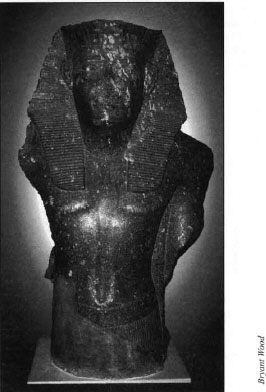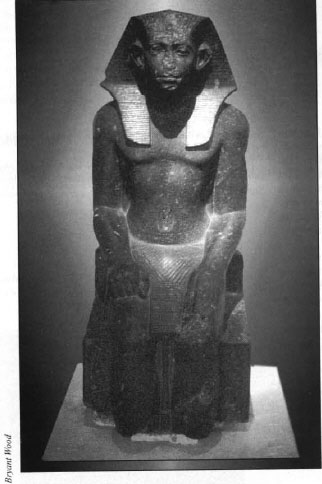
This article is the first in a series of six parts published in Bible and Spade.
No portion of the Old Testament has a richer Egyptian coloring than the story of Joseph. Egyptian names, titles, places, and customs all appear in Genesis 37–50. In the last one hundred years or so, historical and archaeological research has made the study of the Egyptian elements in the Joseph story more fruitful than ever before. In order to examine the Egyptological information, it is necessary to establish the period in Egyptian history when Joseph was in Egypt.
Mainline contemporary scholarship and the Bible’s own chronology are in accord in dating Joseph sometime between 2000 and 1600 BC. This time frame includes two important periods of Egypt’s history, the Middle Kingdom (2000-1786 B.C.) and the Second Intermediate Period (1786-1570 B.C.). However, before narrowing down our dates for Joseph any more, let us first survey these two periods.
The Middle Kingdom was one of Egypt’s three greatest ages (Hayes, 1964) (Aling, 1981). The country was unified and prosperous, and was in the process of conquering Nubia, located in what is today the Sudan. In the Bible, this area is called Ethiopia.
The eight Pharaohs of this period comprise Egypt’s 12th Dynasty. The founder was the great Amenemhat I (1991–1962 BC). He died by assassination, but not before he had associated his son Sesostris I with him on the throne as coregent. Sesostris in his long reign (1971–1928 BC) campaigned with success in northern Nubia and built at no less than 35 sites in Egypt.
Under his immediate successors, fighting in Nubia subsided and trade received the main royal attentions. Since Babylon had not yet emerged as a great power under Hammurabi, Egypt stood alone as the world’s greatest nation.

Sesostris I, ruler of the Middle Kingdom just prior to the time of Joseph.
The most important king of the 12th Dynasty was Sesostris III (1878–1843 BC). He renewed the efforts to conquer Nubia, and was successful. All of Nubia as far south as Semnah was taken. Sesostris III also instituted great administrative reforms. He broke the power of the local nobility. These officials had been a thorn in the side of the Pharaohs all through the 12th Dynasty. We know little in detail of what Sesostris III did, but he did end the semi-independence of the so-called Nomarchs (provincial governors). We will have occasion to return to this point later.
Under Amenemhat III (1842-1797 B.C.) the Middle Kingdom reached its highest level of material prosperity. Egypt was very successful in foreign trade. The exploitation of mines and quarries was greater than ever before, and a project to reclaim land in the Faiyum region to the west of the Nile valley was completed.
The final rulers of the Twelfth Dynasty (including one female king) were weak. As central authority broke down, so did control of Egypt’s borders with Syria-Palestine. This enabled an ever-expanding infiltration of Asiatics to enter Egypt’s delta region. Eventually these Asiatics were able to seize control of northern Egypt, thus ending the Middle Kingdom period of Egyptian history.

Sesostris III, the most important king of the 12th Dynasty. He may have been the Pharaoh on the throne during the years of famine.
The Second Intermediate Period, or as it is sometimes called, “the Hyksos Period,” was not a time of greatness for Egypt. The north was controlled by Asiatics, a group called the Hyksos by the Egyptians. The south was ruled by local Egyptian dynasts of no great power or importance, at least in their early years. [The best study of the Hyksos is John Van Seters, The Hyksos (New Haven: Yale University Press, 1966).]
A few comments on the Hyksos are necessary here. There are several wrong views concerning them which have become popularly held. The first is that they entered Egypt by means of a massive military invasion led by chariots. While the Hyksos probably did introduce the war chariot to Egypt, they most certainly did not enter the country and conquer it in a military campaign. They entered the Nile delta gradually and, finding themselves there in sufficient numbers to do so, simply established one of their leaders as an Egyptian-style Pharaoh. They resided in a capital city called Avaris; later in Egyptian history this city would be re-named “Rameses” after the great king Rameses II (1290–1223 BC).
Another misconception about the Hyksos concerns their name. Josephus, a Jewish historian writing in the first century AD during the days of the great Jewish Revolt against the Roman Empire and Rome’s armies led by Vespasian, said that the term “Hyksos” meant “Shepherd Kings.” This is of course quite wrong. The name Hyksos comes from two Egyptian words meaning “Rulers of Foreign Lands, “and has nothing at all to do with shepherds.
The final incorrect idea regarding the Hyksos is that they ruled all of Egypt. They did not. They only controlled the delta region, at least for any length of time.
During which of these two periods of time did Joseph come to Egypt as a slave? It has become fashionable among scholars to date him to the Hyksos period, since it is generally assumed that the Israelites were fellow Asiatics related to the Hyksos. It is also assumed that, since Joseph eventually rose to a high position in the Egyptian court, the king must have been a fellow countryman of Joseph’s. If we allow for a sojourn of some 400 years in Egypt by the Israelites, and if we accept the so-called Late Date of the Exodus (in the middle 1200’s BC), a date for Joseph around 1650 BC would be perfect.
The Bible, on the other hand, provides us with some very specific chronological data regarding these events. 1 Kings 6:1, a pivotal reference for all Old Testament chronology, dates the Exodus 480 years before the fourth year of Solomon, accepted by virtually all scholars as 966 BC. This places the Exodus in ca. 1446 BC; a date which agrees with the so-called Early Date for the Exodus.
Next, Exodus 12:40 states that Jacob came to dwell in Egypt 430 years before the Exodus. Thus he came to Egypt in ca. 1876 BC. These Biblical references clearly show that Joseph ought to be dated in the Middle Kingdom rather than in the Hyksos Period.
Several specific points in the Joseph story confirm a Middle Kingdom rather than a Hyksos date for Joseph. In Genesis. 41:14 Joseph is called out of prison to meet with the king. Before going to meet the king, Joseph puts on new (clean) clothing and shaves himself. This becomes understandable when we realize that the Egyptians were a clean people and were particularly offended by facial hair.
This verse points to the Pharaoh being a native Egyptian, and not Hyksos. The latter, being Asiatics, were not bothered by facial hair and a general lack of cleanliness. When Joseph is rewarded and promoted by the Pharaoh for interpreting the king’s dream, he is named to be ruler overall the land of Egypt (see Genesis 41). The Hyksos never ruled all the land of Egypt, but the native Egyptian Pharaohs of the Middle Kingdom did.
Also, when Joseph is given a wife by the king as a reward for his interpretation of the dream, the woman is said to be the daughter of Potiphera, Priest of On. On was the center of solar worship in ancient Egypt. The chief god worshiped there was Re or Ra, the northern manifestation of Amon-Re, the supreme deity of both the Middle Kingdom and New Kingdom periods of Egyptian history.
The Hyksos, while they did not persecute the worshipers of Re, did not give that deity the number one position. Their favorite deity was Set, a delta god sometimes regarded by the Egyptians as nearly a devil-like figure. The Hyksos identified Set with the Palestinian god Baal, a god from their Canaanite homeland who was very familiar to them.
Now if Joseph was being rewarded by a Hyksos king, it stands to reason that his new wife would not have been the daughter of a priest of Re, but rather the daughter of a priest of Set. Once again, the Middle Kingdom seems a better choice for datum Joseph than the Second Intermediate Period. Thus, relying on the Biblical chronology and the historical material, we will place Joseph in the Middle Kingdom Period, under two great rulers, Sesostris II (1897–1878 BC) and Sesostris III (1878–1843 BC).
Joseph entered Egypt as a slave. It is interesting to note that slavery was not a very old concept in Egypt. It had not existed earlier in the Old Kingdom, the period when the great pyramids were being built. Those structures were not, as is sometimes stated, built by slave labor. They were constructed by drafted peasant labor.
The Middle Kingdom is the first major period in Egyptian history where slavery was well known. In the 1950s AD, the American Egyptologist William C. Hayes published a famous papyrus document from the Middle Kingdom which had a list of slaves on one side and a discussion of Egyptian prisons on the other (Hayes 1972). In the next issue of Bible and Spade, we will examine the information this valuable papyrus provides for us regarding the story of Joseph.
Bibliography
Aling, C. F.
1981 Egypt and Bible History. Grand Rapids: Baker.
Hayes, W. C.
1964 The Middle Kingdom of Egypt. New York: Cambridge University. 34ff.
Hayes, W. C., ed.
1972 A papyrus of the Late Middle Kingdom in the Brooklyn Museum. Brooklyn: Brooklyn Museum Reprint.
Reprinted in Bible and Spade with permission from Artifax 15.3 (Summer 2000): 20-21.